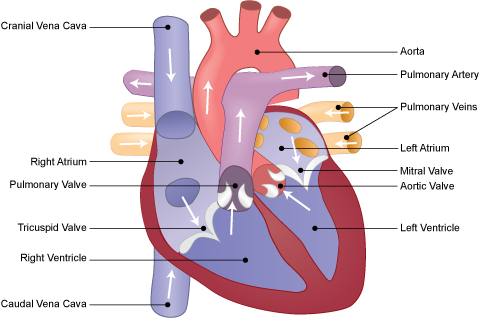Cardiovascular Physiology and Pathophysiology
-
Physiology
Structure and Function4 Topics -
Lymphatics and Edema Formation
-
The Microcirculation
-
Vascular Control3 Topics
-
The Cardiac Cycle
-
Determinants of Myocardial Performance7 Topics
-
Neuro-Control of Heart and Vasculature4 Topics
-
Electro-Mechanical Association4 Topics
-
Electrical Side of the Heart4 Topics
-
PathophysiologyDefining Heart Failure
-
Causes of Heart Failure
-
MVO2 and Heart Failure
-
Cardiac Output and Heart Failure7 Topics
-
Compensation for Circulatory Failure
-
Vascular Tone in Heart Failure
Functions of Heart Components

Pericardium:
Limits cardiac distention with cardiac filling. This effect is greatest on the thin walled chambers such as the atria and the right ventricle.
Right Atrium:
It serves as a storage reservoir for blood returning to the heart via the cranial and caudal vena cavae.
Right Ventricle:
It receives all the blood presented to it via the right atrium and expels this blood to the lungs for gas exchange. Since the pulmonary arterial tree is a rather low-pressure system (as compared to the systemic arteries), the right ventricle develops into a rather thin-walled chamber (as compared to the left ventricle).
Left Atrium:
It serves as a storage reservoir for blood returning from the pulmonary veins.
Left Ventricle:
It receives all the blood presented to it via the left atrium and expels this blood through the systemic arterial tree to the organs of the body. Since the systemic arterial tree is a rather high-pressure system (as compared to the pulmonary arteries), the left ventricle develops into a rather thick-walled chamber (as compared to the right ventricle).
The Atrioventricular (AV) Valves:
They function to promote the unidirectional flow of blood from the atria to the ventricles during diastole. Flow occurs across these valves when the pressure in the ventricles falls below that of the atria. Flow across the AV valves is characterized by three phases of diastole: rapid filling phase at the onset of diastole (responsible for most of the filling of the ventricle), diastasis (minimal flow occurs at this time), and atrial contraction at the end of diastole.
Semilunar Valves:
They function to promote the unidirectional flow of blood from the ventricles into the arterial trees during systole. Flow occurs across these valves when the pressure in the ventricles exceeds that present in the arterial tree.
